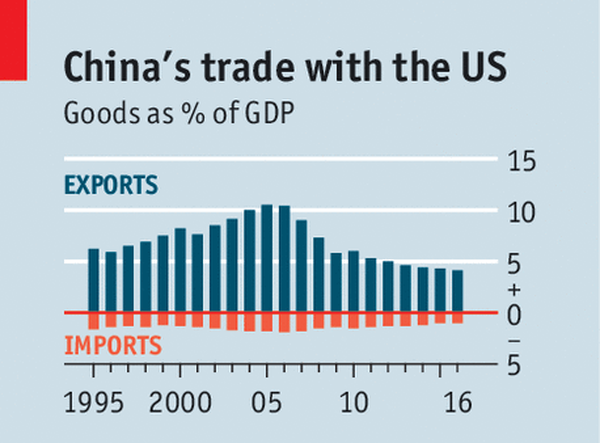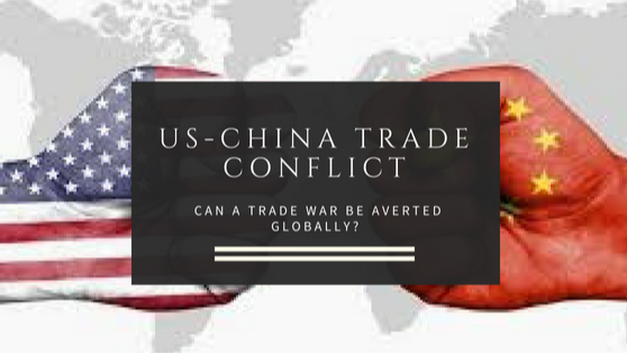ECONOMICS STUDY CENTER, UNIVERSITY OF DHAKA
|
Abdullah-Al Limon In the second year of his presidency, Donald Trump has doubled down on his “America First” brand of economic nationalism, by making impossible demands of US allies and escalating a multi-front ‘Trade War’ of his own making.  Firstly, US President Donald Trump enacted steel and aluminium tariffs aimed squarely at China. On April 2, China retaliated with tariffs on 128 American products. In response on June 15, Trump announced 25% tariffs on another 1,300 Chinese export products which will be activated from 6th July. US administration also listed other Chinese export goods (equivalent to $34 billion) for further tariff imposition. In response, China threatened 25% tariffs on 106 US exports (including soybeans, cars, and aeroplanes), to go into effect whenever the US tariffs do. If these measures go into effect, it will amount to a trade war-one that the United States is not likely to win. China, for its part, is not a major supplier of steel or aluminium to the United States. But Chinese overcapacity has been putting downward pressure on steel and aluminium prices globally. The steel tariff, for example, will help a small number of workers in the steel industry itself, while hurting a much larger number of workers in downstream industries like construction, oil, gas and automobile manufacturing. Again, ‘Federal Communications Commission’ (FCC) has agreed to treat Huawei, ZTE (China’s telecommunication giants) as a national security risk and under the proposed new rule firms with that classification will no longer be able to supply equipment for building Internet infrastructure in the US. Again, America’s current-account deficit implies the acquisition of large amounts of foreign capital which strengthens US’s financial system and currency. Trade policy alone would be insufficient to achieve the goal of reducing the external deficit. It is often said that surplus countries will always be the biggest losers in any tit-for-tat escalation of tariffs, but this assumption misses multiple points. Firstly, China is more economically resilient to the effects of a trade war. Trade as a share of its total economic activity has halved in the past decade, from more than 60% of GDP in 2007 to just over 30% today. As a dictatorship, China can ignore protests by workers and companies suffering from US tariffs. China has already shown itself to be handling US trade pressure in a much more sensible way than Japan did in the 1980s. China’s response- increasing imports and accelerating domestic structural reforms will support high-quality long-term growth. On the contrary US government can’t ignore the outcry from exporters, importers, and consumers facing higher costs. More fundamentally, the US is concerned that China’s rapid economic development now poses a real challenge to America’s global influence which has fueled a sense that China must be “contained”. In Trump’s view, part of the solution is trade protectionism. In the 1980s, protectionist US policies successfully contained the growth of Japan who like China today, maintained a large trade surplus with the US. But those policies’ success was rooted partly in Japan’s problematic policy choices, including slow fiscal and monetary responses. In order to reduce the bilateral trade surplus, Japan introduced so-called ‘Voluntary Export Restraints (VER)’, which hollowed out its real economy and providing excessive protection to its non-tradable sectors resulted in a decade of long recession. China recognizes the absurdity of the Trump administration’s obsession with forcing it to reduce the bilateral trade surplus. To ease trade frictions, unlike Japan’s voluntary export restraints, China’s leaders have also promised to increase imports and open up the domestic market. So, US-goods and services will also enable the country “to meet the growing consumption needs of the Chinese people needed for high-quality economic development”. Greater openness to investment is crucial for China as it seeks to ensure continued technological progress. Here, China will maintain a competitive advantage in manufacturing, because it’s per capita GDP is only one-quarter of that of the US. Already, to promote expanded consumer imports, China will hold its first ‘Import Expo’ in Shanghai in November. To encourage financial investment, China will raise foreign-ownership limits to 51% within three years, on the way of ultimate removal of restrictions. Economic liberalization, selective protection, export subsidies, currency manipulation, state-owned enterprises, domestic-content rules, and technology-transfer requirements have all played a role in making China world’s manufacturing powerhouse. Trump’s trade agenda shows little interest in policies that would improve global trade for all. Such policies should start from the trade regime’s ‘Golden Rule’: “do not impose on other countries constraints that you would not accept if faced with their circumstances”. Trump does not seem to understand how trade works. He thinks that America’s $500 billion trade deficit with China is the result of “incompetent” US administrations allowing their Chinese counterparts to take advantage of them. But trade balances are far more complex than Trump (self-proclaimed dealmaker!) view towards it. Generally, much of what China exports include components manufactured elsewhere, so China’s trade surplus actually includes the trade surpluses of many other countries. One of the main US complaints against China is that the Chinese systematically violate ‘Intellectual Property Rights’ (IP) in order to steal technological secrets. But in the nineteenth century, the US was in the same position in relation to the technological leader of that time, Britain. The fledgeling textile mills of New England were desperate for technology and did their best to steal British designs and smuggle in skilled British craftsmen. As one historian of US business has put it, “the Americans were pirates, too”. In particular, Trump administration takes issue with the ‘Made in China- 2025’ strategy, introduced by China’s State Council in 2015 with the aim of boosting ten strategic industries: including advanced information technology, automated machine tools and robotics, artificial intelligence, high-speed rail, aviation and spaceflight equipment, sophisticated medical products, new power sources as well as advanced agricultural equipment and electric vehicles. ‘US Trade Representatives’ (USTR) report warns that the strategy’s “final goal” is to “capture much larger worldwide market shares” in the targeted industries through unfair trading practices regarding industrial espionage, licensing. It accuses China of “forced technology transfer” arguing that foreign (US) companies have to share their ‘Intellectual Property’ (IP) to gain access to the Chinese market. This transfer is alleged to take place within the structure of ‘Joint-Venture’ arrangements. While the ‘World Trade Organization’ (WTO) prohibits member countries from conditioning market access on such mandatory technology transfers. The Chinese have responded that nothing is mandatory because companies do not have to do business in China. ‘Cyber-Espionage’ is USTR’s another case against China which they called as ‘Cyber-related trade violation’. Trump administration mainly wants to prevent China from catching up to the US technologically. This is obviously not acceptable to China and they may retaliate with countertrade policy favourable to them. So it’s a powerful ammunition in a potential trade war. As Chinese firms have become more competitive, it has been slow to open up its financial markets, much to the displeasure of ‘Wall Street’ investors. So, a ‘Currency War’ alongside a trade war would be disastrous. At a minimum, financial markets could be destabilized and international lending could be disrupted. China has continued to construct islands in the ‘South China Sea’ in order to change territorial facts on the ground. And it has ploughed forward with its ‘Belt and Road initiative’, a challenge to America’s global primacy. The ‘National Security Strategy’ that the Trump administration released in December 2017, China was cited as the main challenger to “American power, influence, and interests”. This perspective fuels the risk of the so-called ‘Thucydides Trap’: ‘an established power’s fear of a rising rival leads to conflict’. Even developed countries have relied on industrial policy to achieve national economic and competitive objectives. Japan’s so-called ‘Planned Rational Development’ perfected the art of state-subsidized credit allocation and tariffs to protect Japan’s sunrise industries, an effort that was matched by Germany’s equally impressive ‘Wirtschaftswunder’ (strong support for the small and medium-sized enterprises). So, the Trump administration wants the benefits of hegemony but is unwilling to bear the costs. In decades of 80’s NASA-related spinoffs, the Internet, GPS, breakthroughs in semiconductors, nuclear power, imaging technology and more: all are important and highly visible manifestations of American industrial policy. So, the USTR’s claim that China alone relies on industrial policy as a means toward this end is highly hypocritical. Economists generally argue that everybody loses in a trade war. Under this scenario, economic disengagement would occur gradually but not completely. Despite the adversarial nature of the relationship, both sides would have some economic incentives to maintain a working relationship. Both the US and Chinese tariffs will significantly hurt Americans. For example, Trump’s tariffs on steel and aluminium will force the US auto industry to raise prices for consumers as its major inputs become more expensive. China’s retaliation hurts other important US economic sectors, from agriculture to manufacturing. Industries and consumers in China would also be hurt by a trade war but its leaders can overrule interest groups and stifle protests. Again if they were targeted, Chinese producers can get around such restrictions by shipping steel to a third country before exporting it to the United States. This may stop American companies from importing some Chinese steel products, but it doesn’t necessarily mean that they will be buying American steel. They can still get cheap steel from elsewhere, like Vietnam or India. Yet Trump thinks that a country with a trade deficit necessarily has the stronger negotiating position. In reality, the surplus country is often in the stronger position, because it has accumulated financial claims against its “opponent.” That is certainly true of China, which holds well over $1 trillion of US Treasury securities. If the Chinese government dumped its US holdings/ stop buying Treasury securities, the resulting price decline would hurt both countries. This outcome would further undermine confidence in financial markets responding to every tariff announcement with a selloff. This probable ‘US-China Trade Conflict’ (self-destructive beggar-thy-neighbour policy!) may affect global trade. Trade patterns have changed much since the 1980s, particularly owing to the emergence of regional and global supply chains as well as a web of cross-border inter-dependencies in production and consumption. Supply chains now can have as many significant international links as domestic ones, and a substantial share of internal demand is being met by products partly or wholly produced abroad. For the longer-term health of both individual participants and the overall system, these relationships must function effectively, based on a cooperative approach that is deemed credible. If not, it may result in a lower level of growth and welfare. This is why the current confrontation between the US and China has raised fears of serious damage, particularly if it leads to ever-greater protectionism and a wider “Trade War”. Trump claims that “trade wars are good and easy to win” but actually no one will emerge as the winner in a trade war. (More destructive than zero-sum game). A global trade war would undermine economic recovery, hurt businesses and consumers by encumbering global supply chains and raising prices for imported goods. The Asian economies with export-dependent growth models – such as Vietnam (exports constitute 90% of GDP), Malaysia (71%), and South Korea (45%) – would be hit particularly hard. As currently set up international economic order needs to function as a cooperative game, in which each participant commits to free and fair trade. The commitments are credible and verifiable, mechanisms are in place to facilitate and monitor collaboration, and cheaters face effective penalties. Current trade tensions could shift this cooperative game to a non-cooperative one, with elements of a “Prisoner’s Dilemma”, in which self-interested action turns out to be both individually and mutually destructive. But this would mean losses for virtually all countries. In the real world, only multilateral trade deficit matters; not bilateral trade deficits with any one country. Reducing imports from China will not create jobs in the US. Rather, it will increase prices for ordinary Americans and create jobs in Bangladesh, Vietnam, or any other country that steps in to replace the imports that previously came from China. China’s trade surplus and the US trade deficit ultimately reflect saving and investment imbalances. The non-market “trade remedies” being considered by the US and China might produce a smaller trade imbalance between the two economies, but at the cost of a larger imbalance with the rest of the world. For those still hoping against hope, the good news is that, behind the scenes, the US and China are still talking. To avoid a probable ‘Sino-American Trade War’ which may entail high costs for both sides, for Asia, and for global trade stability; China seems eager to ease tensions. Recent pledge to lower tariffs on imported American cars and announcement of the opening of China’s financial-services sector are some steps of them. So, one hopes that the war drums will be silenced through negotiation and mutual concessions.
3 Comments
Rafiul Ahmed
9/9/2018 12:12:14 am
Well analyzed article. I was eagerly searching an article on this issue. Great work.
Reply
5/1/2024 06:05:42 pm
Thanks for your post.cube Star International Ltd.is a Global Trade Navigator.We simplify import and export.
Reply
5/7/2024 09:49:23 pm
Thanks for your post.cube Star International Ltd.is a Global Trade Navigator.We simplify import and export.
Reply
Leave a Reply. |
Send your articles to: |


